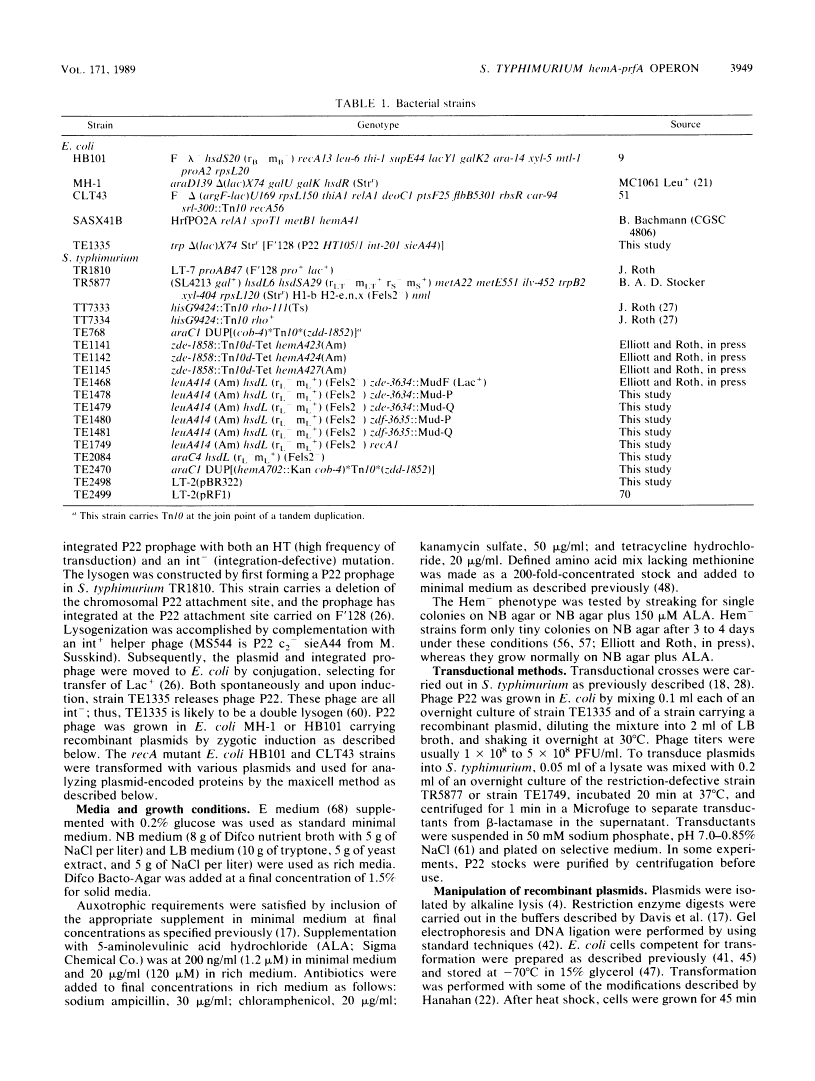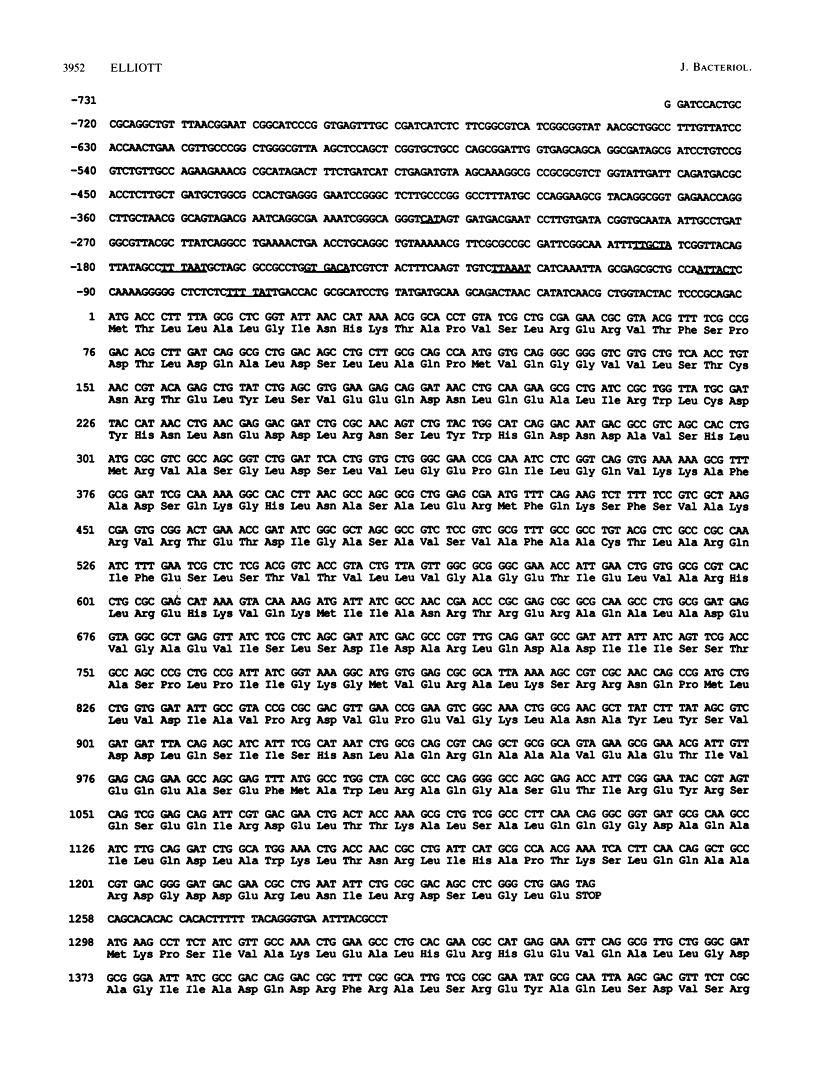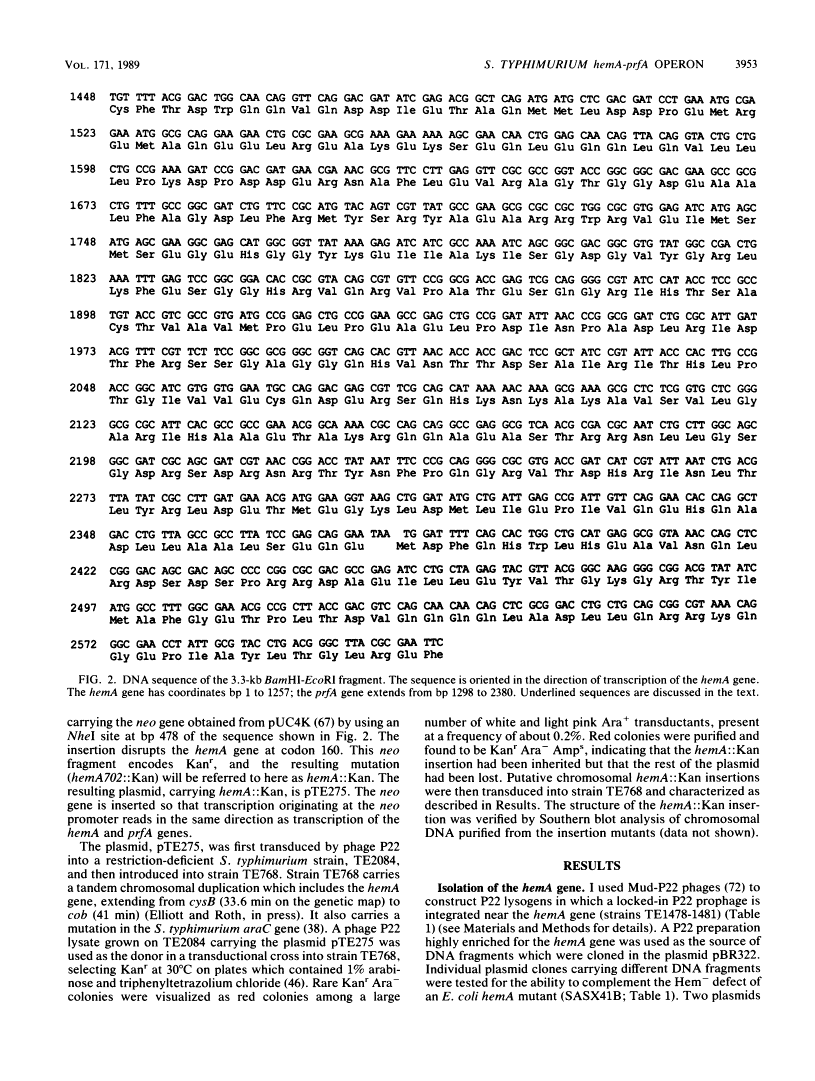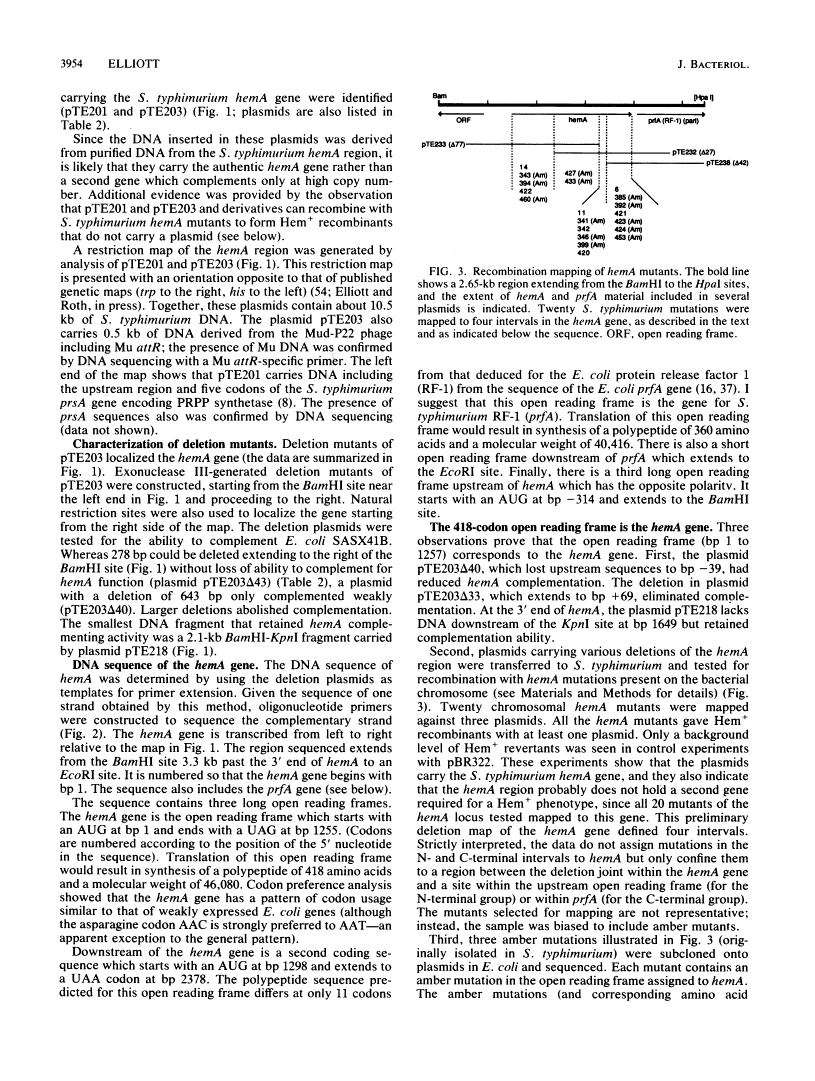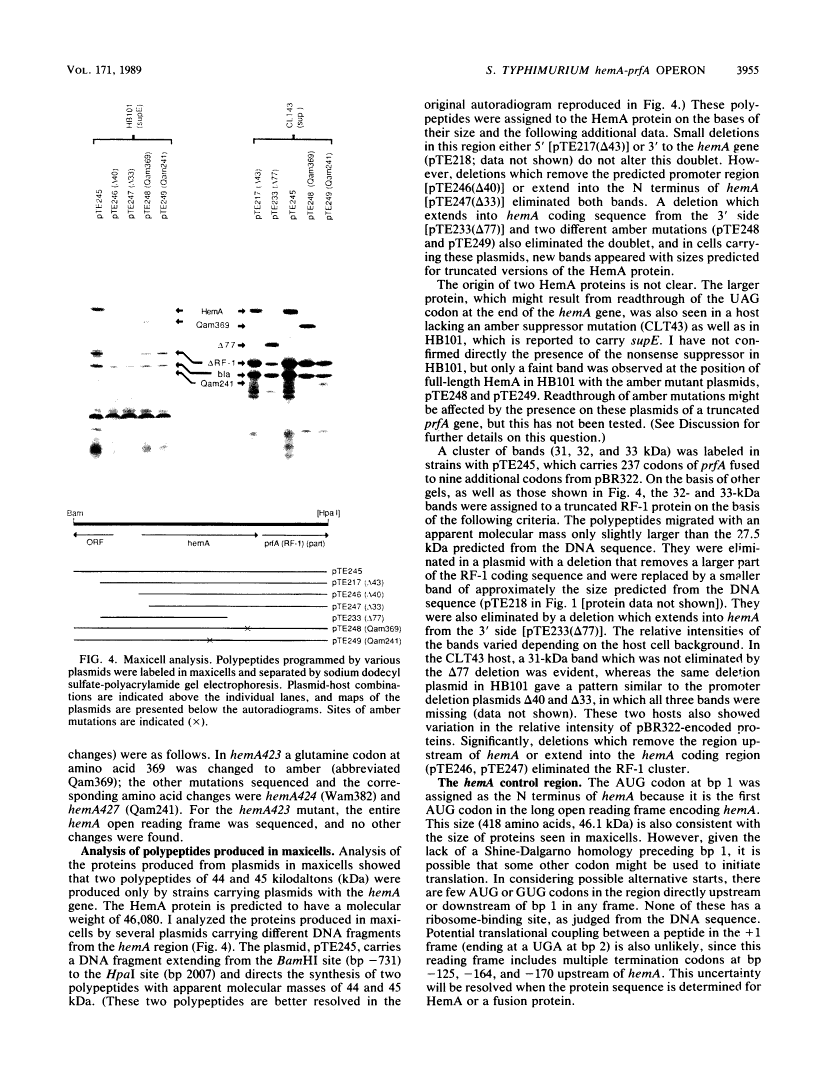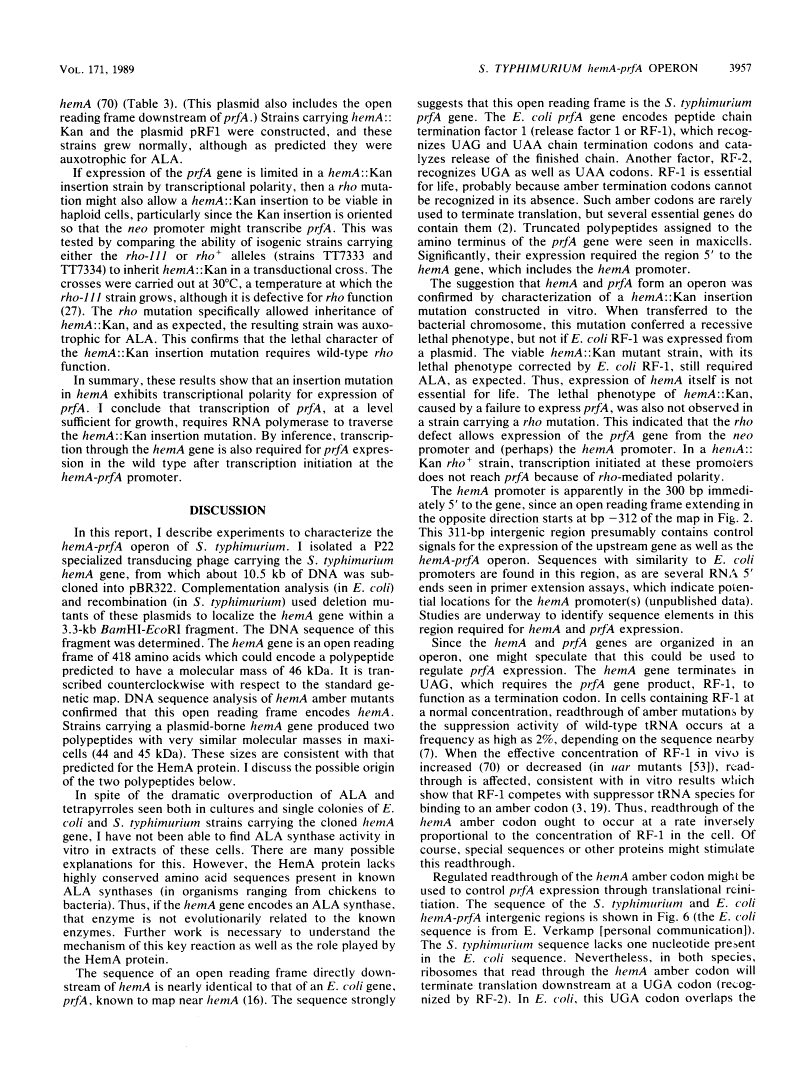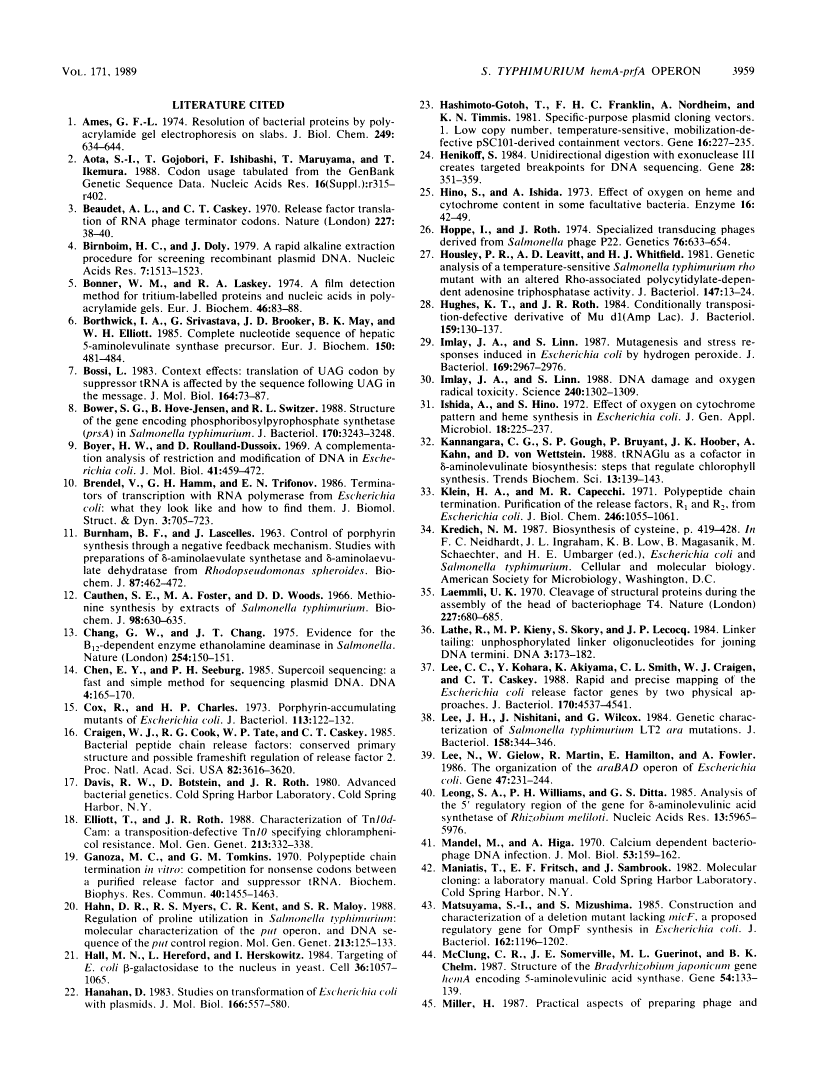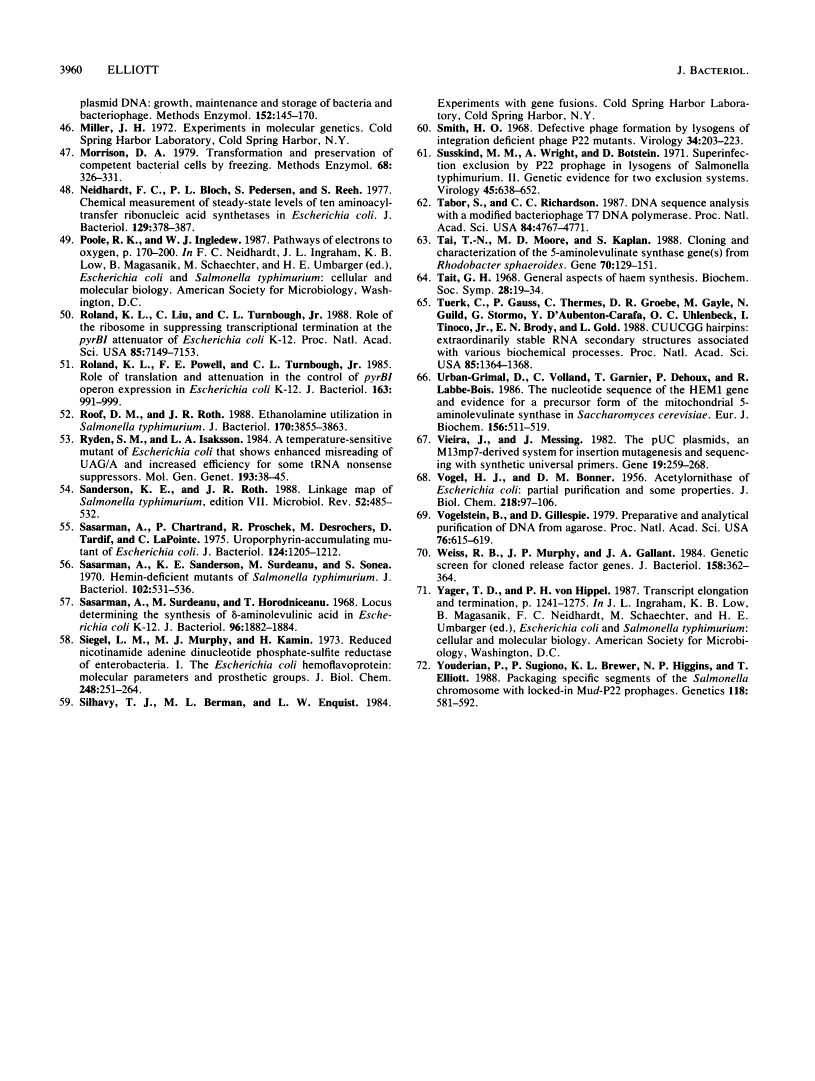Abstract
Free full text

Cloning, genetic characterization, and nucleotide sequence of the hemA-prfA operon of Salmonella typhimurium.
Abstract
The first step in heme biosynthesis is the formation of 5-aminolevulinic acid (ALA). Mutations in two genes, hemA and hemL, result in auxotrophy for ALA in Salmonella typhimurium, but the roles played by these genes and the mechanism of ALA synthesis are not understood. I have cloned and sequenced the S. typhimurium hemA gene. The predicted polypeptide sequence for the HemA protein shows no similarity to known ALA synthases, and no ALA synthase activity was detected in extracts prepared from strains carrying the cloned hemA gene. Genetic analysis, DNA sequencing of amber mutations, and maxicell studies proved that the open reading frame identified in the DNA sequence encodes HemA. Another surprising finding of this study is that hemA lies directly upstream of prfA, which encodes peptide chain release factor 1 (RF-1). A hemA::Kan insertion mutation, constructed in vitro, was transferred to the chromosome and used to show that these two genes form an operon. The hemA gene ends with an amber codon, recognized by RF-1. I suggest a model for autogenous control of prfA expression by translation reinitiation.
Full text
Full text is available as a scanned copy of the original print version. Get a printable copy (PDF file) of the complete article (3.0M), or click on a page image below to browse page by page. Links to PubMed are also available for Selected References.
Images in this article
Click on the image to see a larger version.
Selected References
These references are in PubMed. This may not be the complete list of references from this article.
- Ames GF. Resolution of bacterial proteins by polyacrylamide gel electrophoresis on slabs. Membrane, soluble, and periplasmic fractions. J Biol Chem. 1974 Jan 25;249(2):634–644. [Abstract] [Google Scholar]
- Aota S, Gojobori T, Ishibashi F, Maruyama T, Ikemura T. Codon usage tabulated from the GenBank Genetic Sequence Data. Nucleic Acids Res. 1988;16 (Suppl):r315–r402. [Europe PMC free article] [Abstract] [Google Scholar]
- Beaudet AL, Caskey CT. Release factor translation of RNA phage terminator codons. Nature. 1970 Jul 4;227(5253):38–40. [Abstract] [Google Scholar]
- Birnboim HC, Doly J. A rapid alkaline extraction procedure for screening recombinant plasmid DNA. Nucleic Acids Res. 1979 Nov 24;7(6):1513–1523. [Europe PMC free article] [Abstract] [Google Scholar]
- Bonner WM, Laskey RA. A film detection method for tritium-labelled proteins and nucleic acids in polyacrylamide gels. Eur J Biochem. 1974 Jul 1;46(1):83–88. [Abstract] [Google Scholar]
- Borthwick IA, Srivastava G, Day AR, Pirola BA, Snoswell MA, May BK, Elliott WH. Complete nucleotide sequence of hepatic 5-aminolaevulinate synthase precursor. Eur J Biochem. 1985 Aug 1;150(3):481–484. [Abstract] [Google Scholar]
- Bossi L. Context effects: translation of UAG codon by suppressor tRNA is affected by the sequence following UAG in the message. J Mol Biol. 1983 Feb 15;164(1):73–87. [Abstract] [Google Scholar]
- Bower SG, Hove-Jensen B, Switzer RL. Structure of the gene encoding phosphoribosylpyrophosphate synthetase (prsA) in Salmonella typhimurium. J Bacteriol. 1988 Jul;170(7):3243–3248. [Europe PMC free article] [Abstract] [Google Scholar]
- Boyer HW, Roulland-Dussoix D. A complementation analysis of the restriction and modification of DNA in Escherichia coli. J Mol Biol. 1969 May 14;41(3):459–472. [Abstract] [Google Scholar]
- Brendel V, Hamm GH, Trifonov EN. Terminators of transcription with RNA polymerase from Escherichia coli: what they look like and how to find them. J Biomol Struct Dyn. 1986 Feb;3(4):705–723. [Abstract] [Google Scholar]
- BURNHAM BF, PIERCE WS, WILLIAMS KR, BOYER MH, KIRBY CK. delta-aminolaevulate dehydratase from Rhodopseudomonas spheroides. Biochem J. 1963 Jun;87:462–472. [Europe PMC free article] [Abstract] [Google Scholar]
- Cauthen SE, Foster MA, Woods DD. Methionine synthesis by extracts of Salmonella typhimurium. Biochem J. 1966 Feb;98(2):630–635. [Europe PMC free article] [Abstract] [Google Scholar]
- Chang GW, Chang JT. Evidence for the B12-dependent enzyme ethanolamine deaminase in Salmonella. Nature. 1975 Mar 13;254(5496):150–151. [Abstract] [Google Scholar]
- Chen EY, Seeburg PH. Supercoil sequencing: a fast and simple method for sequencing plasmid DNA. DNA. 1985 Apr;4(2):165–170. [Abstract] [Google Scholar]
- Cox R, Charles HP. Porphyrin-accumulating mutants of Escherichia coli. J Bacteriol. 1973 Jan;113(1):122–132. [Europe PMC free article] [Abstract] [Google Scholar]
- Craigen WJ, Cook RG, Tate WP, Caskey CT. Bacterial peptide chain release factors: conserved primary structure and possible frameshift regulation of release factor 2. Proc Natl Acad Sci U S A. 1985 Jun;82(11):3616–3620. [Europe PMC free article] [Abstract] [Google Scholar]
- Elliott T, Roth JR. Characterization of Tn10d-Cam: a transposition-defective Tn10 specifying chloramphenicol resistance. Mol Gen Genet. 1988 Aug;213(2-3):332–338. [Abstract] [Google Scholar]
- Ganoza MC, Tomkins JK. Polypeptide chain termination in vitro: competition for nonsense codons between a purified release factor and suppressor tRNA. Biochem Biophys Res Commun. 1970 Sep 30;40(6):1455–1463. [Abstract] [Google Scholar]
- Hahn DR, Myers RS, Kent CR, Maloy SR. Regulation of proline utilization in Salmonella typhimurium: molecular characterization of the put operon, and DNA sequence of the put control region. Mol Gen Genet. 1988 Jul;213(1):125–133. [Abstract] [Google Scholar]
- Hall MN, Hereford L, Herskowitz I. Targeting of E. coli beta-galactosidase to the nucleus in yeast. Cell. 1984 Apr;36(4):1057–1065. [Abstract] [Google Scholar]
- Hanahan D. Studies on transformation of Escherichia coli with plasmids. J Mol Biol. 1983 Jun 5;166(4):557–580. [Abstract] [Google Scholar]
- Hashimoto-Gotoh T, Franklin FC, Nordheim A, Timmis KN. Specific-purpose plasmid cloning vectors. I. Low copy number, temperature-sensitive, mobilization-defective pSC101-derived containment vectors. Gene. 1981 Dec;16(1-3):227–235. [Abstract] [Google Scholar]
- Henikoff S. Unidirectional digestion with exonuclease III creates targeted breakpoints for DNA sequencing. Gene. 1984 Jun;28(3):351–359. [Abstract] [Google Scholar]
- Hino S, Ishida A. Effect of oxygen on heme and cytochrome content in some facultative bacteria. Enzyme. 1973;16(1):42–49. [Abstract] [Google Scholar]
- Hoppe I, Roth J. Specialized transducing phages derived from salmonella phage P22. Genetics. 1974 Apr;76(4):633–654. [Europe PMC free article] [Abstract] [Google Scholar]
- Housley PR, Leavitt AD, Whitfield HJ. Genetic analysis of a temperature-sensitive Salmonella typhimurium rho mutant with an altered rho-associated polycytidylate-dependent adenosine triphosphatase activity. J Bacteriol. 1981 Jul;147(1):13–24. [Europe PMC free article] [Abstract] [Google Scholar]
- Hughes KT, Roth JR. Conditionally transposition-defective derivative of Mu d1(Amp Lac). J Bacteriol. 1984 Jul;159(1):130–137. [Europe PMC free article] [Abstract] [Google Scholar]
- Imlay JA, Linn S. Mutagenesis and stress responses induced in Escherichia coli by hydrogen peroxide. J Bacteriol. 1987 Jul;169(7):2967–2976. [Europe PMC free article] [Abstract] [Google Scholar]
- Imlay JA, Linn S. DNA damage and oxygen radical toxicity. Science. 1988 Jun 3;240(4857):1302–1309. [Abstract] [Google Scholar]
- Kannangara CG, Gough SP, Bruyant P, Hoober JK, Kahn A, von Wettstein D. tRNA(Glu) as a cofactor in delta-aminolevulinate biosynthesis: steps that regulate chlorophyll synthesis. Trends Biochem Sci. 1988 Apr;13(4):139–143. [Abstract] [Google Scholar]
- Klein H, Capecchi MR. Polypetide chain termination. Purification of the release factors, R1 and R2, from Escherichia coli. J Biol Chem. 1971 Feb 25;246(4):1055–1061. [Abstract] [Google Scholar]
- Laemmli UK. Cleavage of structural proteins during the assembly of the head of bacteriophage T4. Nature. 1970 Aug 15;227(5259):680–685. [Abstract] [Google Scholar]
- Lathe R, Kieny MP, Skory S, Lecocq JP. Linker tailing: unphosphorylated linker oligonucleotides for joining DNA termini. DNA. 1984;3(2):173–182. [Abstract] [Google Scholar]
- Lee CC, Kohara Y, Akiyama K, Smith CL, Craigen WJ, Caskey CT. Rapid and precise mapping of the Escherichia coli release factor genes by two physical approaches. J Bacteriol. 1988 Oct;170(10):4537–4541. [Europe PMC free article] [Abstract] [Google Scholar]
- Lee JH, Nishitani J, Wilcox G. Genetic characterization of Salmonella typhimurium LT2 ara mutations. J Bacteriol. 1984 Apr;158(1):344–346. [Europe PMC free article] [Abstract] [Google Scholar]
- Lee N, Gielow W, Martin R, Hamilton E, Fowler A. The organization of the araBAD operon of Escherichia coli. Gene. 1986;47(2-3):231–244. [Abstract] [Google Scholar]
- Leong SA, Williams PH, Ditta GS. Analysis of the 5' regulatory region of the gene for delta-aminolevulinic acid synthetase of Rhizobium meliloti. Nucleic Acids Res. 1985 Aug 26;13(16):5965–5976. [Europe PMC free article] [Abstract] [Google Scholar]
- Mandel M, Higa A. Calcium-dependent bacteriophage DNA infection. J Mol Biol. 1970 Oct 14;53(1):159–162. [Abstract] [Google Scholar]
- Matsuyama S, Mizushima S. Construction and characterization of a deletion mutant lacking micF, a proposed regulatory gene for OmpF synthesis in Escherichia coli. J Bacteriol. 1985 Jun;162(3):1196–1202. [Europe PMC free article] [Abstract] [Google Scholar]
- McClung CR, Somerville JE, Guerinot ML, Chelm BK. Structure of the Bradyrhizobium japonicum gene hemA encoding 5-aminolevulinic acid synthase. Gene. 1987;54(1):133–139. [Abstract] [Google Scholar]
- Morrison DA. Transformation and preservation of competent bacterial cells by freezing. Methods Enzymol. 1979;68:326–331. [Abstract] [Google Scholar]
- Neidhardt FC, Bloch PL, Pedersen S, Reeh S. Chemical measurement of steady-state levels of ten aminoacyl-transfer ribonucleic acid synthetases in Escherichia coli. J Bacteriol. 1977 Jan;129(1):378–387. [Europe PMC free article] [Abstract] [Google Scholar]
- Roland KL, Liu CG, Turnbough CL., Jr Role of the ribosome in suppressing transcriptional termination at the pyrBI attenuator of Escherichia coli K-12. Proc Natl Acad Sci U S A. 1988 Oct;85(19):7149–7153. [Europe PMC free article] [Abstract] [Google Scholar]
- Roland KL, Powell FE, Turnbough CL., Jr Role of translation and attenuation in the control of pyrBI operon expression in Escherichia coli K-12. J Bacteriol. 1985 Sep;163(3):991–999. [Europe PMC free article] [Abstract] [Google Scholar]
- Roof DM, Roth JR. Ethanolamine utilization in Salmonella typhimurium. J Bacteriol. 1988 Sep;170(9):3855–3863. [Europe PMC free article] [Abstract] [Google Scholar]
- Rydén SM, Isaksson LA. A temperature-sensitive mutant of Escherichia coli that shows enhanced misreading of UAG/A and increased efficiency for some tRNA nonsense suppressors. Mol Gen Genet. 1984;193(1):38–45. [Abstract] [Google Scholar]
- Sanderson KE, Roth JR. Linkage map of Salmonella typhimurium, edition VII. Microbiol Rev. 1988 Dec;52(4):485–532. [Europe PMC free article] [Abstract] [Google Scholar]
- Săsărman A, Chartrand P, Proschek R, Desrochers M, Tardif D, Lapointe C. Uroporphyrin-accumulating mutant of Escherichia coli K-12. J Bacteriol. 1975 Dec;124(3):1205–1212. [Europe PMC free article] [Abstract] [Google Scholar]
- Săsărman A, Sanderson KE, Surdeanu M, Sonea S. Hemin-deficient mutants of Salmonella typhimurium. J Bacteriol. 1970 May;102(2):531–536. [Europe PMC free article] [Abstract] [Google Scholar]
- Săsărman A, Surdeanu M, Horodniceanu T. Locus determining the synthesis of delta-aminolevulinic acid in Escherichia coli K-12. J Bacteriol. 1968 Nov;96(5):1882–1884. [Europe PMC free article] [Abstract] [Google Scholar]
- Siegel LM, Murphy MJ, Kamin H. Reduced nicotinamide adenine dinucleotide phosphate-sulfite reductase of enterobacteria. I. The Escherichia coli hemoflavoprotein: molecular parameters and prosthetic groups. J Biol Chem. 1973 Jan 10;248(1):251–264. [Abstract] [Google Scholar]
- Smith HO. Defective phage formation by lysogens of integration deficient phage P22 mutants. Virology. 1968 Feb;34(2):203–223. [Abstract] [Google Scholar]
- Susskind MM, Wright A, Botstein D. Superinfection exclusion by P22 prophage in lysogens of Salmonella typhimurium. II. Genetic evidence for two exclusion systems. Virology. 1971 Sep;45(3):638–652. [Abstract] [Google Scholar]
- Tabor S, Richardson CC. DNA sequence analysis with a modified bacteriophage T7 DNA polymerase. Proc Natl Acad Sci U S A. 1987 Jul;84(14):4767–4771. [Europe PMC free article] [Abstract] [Google Scholar]
- Tai TN, Moore MD, Kaplan S. Cloning and characterization of the 5-aminolevulinate synthase gene(s) from Rhodobacter sphaeroides. Gene. 1988 Oct 15;70(1):139–151. [Abstract] [Google Scholar]
- Ta GH. General aspects of haem synthesis. Biochem Soc Symp. 1968;28:19–34. [Abstract] [Google Scholar]
- Tuerk C, Gauss P, Thermes C, Groebe DR, Gayle M, Guild N, Stormo G, d'Aubenton-Carafa Y, Uhlenbeck OC, Tinoco I, Jr, et al. CUUCGG hairpins: extraordinarily stable RNA secondary structures associated with various biochemical processes. Proc Natl Acad Sci U S A. 1988 Mar;85(5):1364–1368. [Europe PMC free article] [Abstract] [Google Scholar]
- Urban-Grimal D, Volland C, Garnier T, Dehoux P, Labbe-Bois R. The nucleotide sequence of the HEM1 gene and evidence for a precursor form of the mitochondrial 5-aminolevulinate synthase in Saccharomyces cerevisiae. Eur J Biochem. 1986 May 2;156(3):511–519. [Abstract] [Google Scholar]
- Vieira J, Messing J. The pUC plasmids, an M13mp7-derived system for insertion mutagenesis and sequencing with synthetic universal primers. Gene. 1982 Oct;19(3):259–268. [Abstract] [Google Scholar]
- VOGEL HJ, BONNER DM. Acetylornithinase of Escherichia coli: partial purification and some properties. J Biol Chem. 1956 Jan;218(1):97–106. [Abstract] [Google Scholar]
- Vogelstein B, Gillespie D. Preparative and analytical purification of DNA from agarose. Proc Natl Acad Sci U S A. 1979 Feb;76(2):615–619. [Europe PMC free article] [Abstract] [Google Scholar]
- Weiss RB, Murphy JP, Gallant JA. Genetic screen for cloned release factor genes. J Bacteriol. 1984 Apr;158(1):362–364. [Europe PMC free article] [Abstract] [Google Scholar]
- Youderian P, Sugiono P, Brewer KL, Higgins NP, Elliott T. Packaging specific segments of the Salmonella chromosome with locked-in Mud-P22 prophages. Genetics. 1988 Apr;118(4):581–592. [Europe PMC free article] [Abstract] [Google Scholar]
Associated Data
Articles from Journal of Bacteriology are provided here courtesy of American Society for Microbiology (ASM)
Full text links
Read article at publisher's site: https://doi.org/10.1128/jb.171.7.3948-3960.1989
Read article for free, from open access legal sources, via Unpaywall:
https://europepmc.org/articles/pmc210147?pdf=render
Free after 4 months at jb.asm.org
http://jb.asm.org/cgi/reprint/171/7/3948
Free to read at jb.asm.org
http://jb.asm.org/cgi/content/abstract/171/7/3948
Citations & impact
Impact metrics
Citations of article over time
Smart citations by scite.ai
Explore citation contexts and check if this article has been
supported or disputed.
https://scite.ai/reports/10.1128/jb.171.7.3948-3960.1989
Article citations
Tolyporphins-Exotic Tetrapyrrole Pigments in a Cyanobacterium-A Review.
Molecules, 28(16):6132, 18 Aug 2023
Cited by: 2 articles | PMID: 37630384 | PMCID: PMC10459692
Review Free full text in Europe PMC
Identification of Putative Biosynthetic Gene Clusters for Tolyporphins in Multiple Filamentous Cyanobacteria.
Life (Basel), 11(8):758, 28 Jul 2021
Cited by: 3 articles | PMID: 34440502 | PMCID: PMC8401325
Collateral Toxicity Limits the Evolution of Bacterial Release Factor 2 toward Total Omnipotence.
Mol Biol Evol, 37(10):2918-2930, 01 Oct 2020
Cited by: 3 articles | PMID: 32437534 | PMCID: PMC7530605
Novel Escherichia coli RF1 mutants with decreased translation termination activity and increased sensitivity to the cytotoxic effect of the bacterial toxins Kid and RelE.
Mol Microbiol, 71(1):66-78, 28 Oct 2008
Cited by: 6 articles | PMID: 19019162 | PMCID: PMC2680264
Cloning, expression, purification, crystallization and preliminary X-ray diffraction analysis of the glutamate-1-semialdehyde aminotransferase from Bacillus subtilis.
Acta Crystallogr Sect F Struct Biol Cryst Commun, 62(pt 5):483-485, 28 Apr 2006
Cited by: 0 articles | PMID: 16682782 | PMCID: PMC2219978
Go to all (68) article citations
Data
Data behind the article
This data has been text mined from the article, or deposited into data resources.
BioStudies: supplemental material and supporting data
Similar Articles
To arrive at the top five similar articles we use a word-weighted algorithm to compare words from the Title and Abstract of each citation.
Isolation, nucleotide sequence, and preliminary characterization of the Escherichia coli K-12 hemA gene.
J Bacteriol, 171(9):4728-4735, 01 Sep 1989
Cited by: 52 articles | PMID: 2548996 | PMCID: PMC210273
Cloning and sequence of the Salmonella typhimurium hemL gene and identification of the missing enzyme in hemL mutants as glutamate-1-semialdehyde aminotransferase.
J Bacteriol, 172(12):7071-7084, 01 Dec 1990
Cited by: 40 articles | PMID: 2254275 | PMCID: PMC210830
Heme-deficient mutants of Salmonella typhimurium: two genes required for ALA synthesis.
Mol Gen Genet, 216(2-3):303-314, 01 Apr 1989
Cited by: 30 articles | PMID: 2664454
Salmonella typhimurium prfA mutants defective in release factor 1.
J Bacteriol, 173(13):4144-4154, 01 Jul 1991
Cited by: 24 articles | PMID: 2061291 | PMCID: PMC208064
Funding
Funders who supported this work.
NCI NIH HHS (1)
Grant ID: CA13148
NIGMS NIH HHS (1)
Grant ID: GM40403

